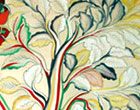FIRST YEAR -Course Outline
Course Overview and Introduction to Traditional Tibetan Medicine (TTM)
- The Objectives of TTM
- TTM as a holistic system
- The benefits of TTM
- TTM as a living ancient knowledge: a natural and holistic medical science
The Four Tantras (Tib. rGyud bZhi)
- Root Tantra (Tib. rTsa rGyud) - The root of TTM; Eight branches
- Explanatory Tantra (Tib. bShad rGyud) - Basic studies; Eleven principles
- Oral Instruction Tantra (Tib. Man Ngag rGyud) - Pathology and treatment; Fifteen divisions
- Final Action Tantra (Tib. Phyi Ma rGyud) - Diagnosis and therapies, Four compilations
Root Tantra and its Three Basic Views – The Three Trees
- The Tree of our General Condition "The Basis of Health and Disease"
- The Tree of Diagnosis
- The Tree of Treatment Methods
Brief Presentation of the 99 Medical Trees
Fundamental Principles:
5 Elements Theory and Cosmology (Tib. ’Byung ba lNga)
- 5 Elements (’Byung ba) – creation of the internal organs
- 5 Energies (Khams) – the five external elements
- Union of the 5 Elements and the 5 Energies
3 Humors Theory (Tib. Nyes Pa gSum)
- Origin
- Quality
- Divisions
- Functions
The Philosophical Basis of Tibetan Medicine
Dharma Philosophy
- Theory of Interdependent Origination (Tib. rTen ’Brel)
- Middle path - Uma (Tib. dBu ma)
The Origins of Tibetan Medicine
Natural Science
- Knowledge acquired from nature spirits
- Knowledge acquired from animal intelligence
- Human observation and discovery
Bon Source.
- Shamanic studies – the harmony between human, spirit and nature
- Philosophical
TTM and its combination with Other Studies
- Philosophy, Bon, Buddha dharma. (Tib. Bon, Ngang pa, Sang rGyas)
- Astrology, the horoscope and constellations (Tib. Nag rTsis, dKar rTsis)
- Geomancy (Tib. Sa dPyad)
The History of Tibetan Medicine
The First Tibetan Physician
Chebu Trishe (dPyad bu Khri shes ) - his study, research and works
The Influence of the sPu rGyal Dynasty (126 – 254 BC)
- King Nyatri Tsanpo
- Development of the ‘12 Studies of Bon’
The Doctor of the First Century Dr. Lhabu Gokar – first surgeries; Wound healing formula (Tib. bChad ’Byor Nyi Shu)
King Lhatho Thori Nyantsa and his descendants (1054 - 10629 CE)
- Physician Biga Gache and his sister Bilha Gazema
- Dunggi Thorchog Chan
- Five principle studies: Pulse reading, diet, herbal formulae, treatment of injuries, external therapies
- The Royal physicians
8th century
Yuthok Yonten Gonpo The Elder and his outstanding Research
- Father of TTM
- rGyud bZhi and the First TTM school
Great Tertons (gTer sTon) and their contribution to TTM
- Terton Graba Ngonshe
- Terton Lama
- Nyang Nyimai Odser
12th century
Yuthok Yonten Gonpo The Younger and his students
- Yuthok The Younger’s new edition of the rGyud bZhi
- Yuthok Nyingthig Practice
Period of Sakya (1247-1354) Trang Ti family and the Sakya Medicine school
Period of Phag Gru (1354-1618)
Two main schools:
- Chang school (Tib. Byang pa)
- Zur school
The 15th and 16th Centuries
Gaden Phodrang government and its support for TTM
- The famous Chagpori
- TTM development in the east (Amdo) and north (Kham) areas of Tibet
TTM in other parts of the world: Mongolia, Bhutan, Russia, India, Nepal.
The Ideal Conduct of the Tibetan Medicine Doctor
Anatomy
Summary of the Explanatory Tantra:
Embryology
- Causes for formation of the body
- Development of the fetus
- Signs of delivery
Metaphors of the Body
- Exterior of the body
- Internal organs
Physical Anatomy
- Physical measurements; quantities of the bodily constituents
- Anatomy of the channels
- Anatomy of critical points
- Tubular pathways
Anatomy of the Head
- Different head shapes
- The Brain
- Bones of the head
- Muscles of the head
- The three channels of the head
Anatomy of the Trunk
- Bones of the trunk
- Muscles of the trunk
- Five solid organs
- Six hollow organs
- Connecting channels
- Grid study for internal organ location (Tib. Byang Khog Yul Thig)
Anatomy of the Limbs (Tib. Yan Lag gi gNad Lugs)
- Muscles of the limbs
- Bones of the limbs
- Lymph nodes
- Critical channels
- Critical Bones of the limbs
- Critical tendons and ligaments
- Summary of the critical points
Subtle Anatomy
- Three channels
- Five chakras
Physiology
- 3 Humors
- 5 Elements – their locations and functions in the physical body
- Metabolic heat
Divisions and Classifications of the Body
- Typology
- Function of the three doors – Body, Speech and Mind
- Classifications of illness
Death and Dissolution of the Body
Signs of death:
- Dream signs
- Distant signs
- Close signs
- The process of death and dying
- The bardo state
- Summary
|


